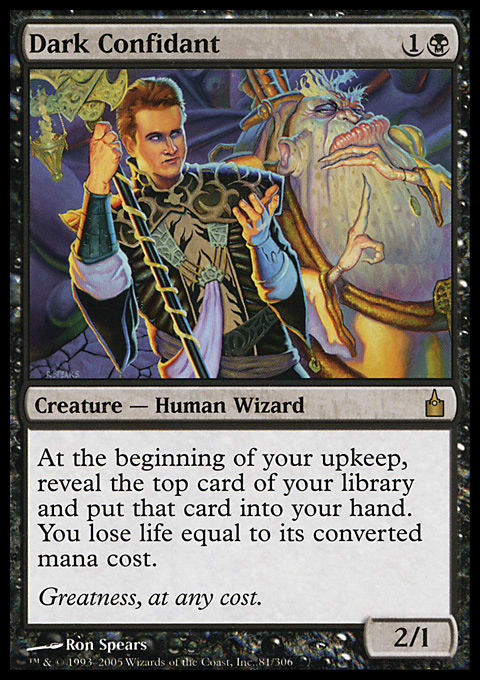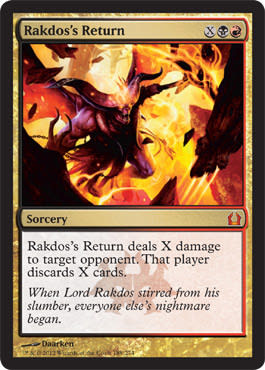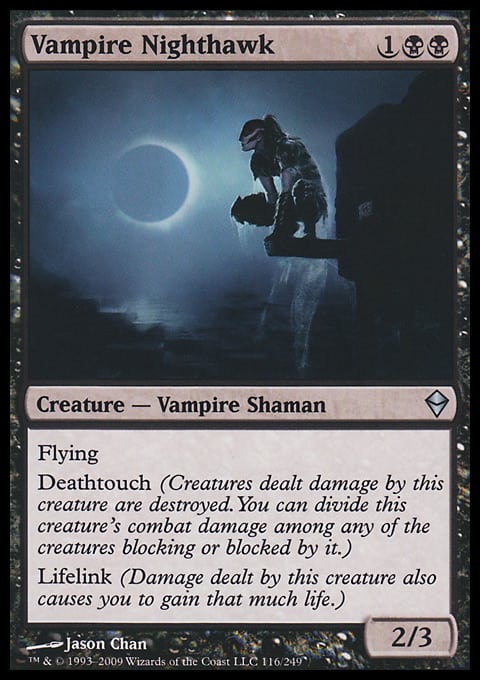Every so often, a card comes along that really piques my interest. A card so interesting and—because I’m mostly Spike with a bit of Johnny—powerful that every one of my new decks becomes geared toward maximizing that particular card. A card so interesting it brings me out from behind my cushy Wizards of the Coast–funded coverage gig to actually say something original about said card rather than describe what other people did with it at a Grand Prix or Pro Tour.
Who am I that you should even care? That’s a question I get a lot, actually.

Spoiler alert: I am neither an elf nor Magic: The Gathering.
Granted, I’m a bit more recognizable these days, mostly as one of the guys on a laptop in the background of GP finals and PTs.
But truth be told, I’ve been at this a very long time, though real life and my coverage gigs mostly keep me from attempting any high level of play. Even when a Grand Prix comes to my hometown of Austin or somewhere nearby, chances are I’ll pick up the coverage gig rather than the playing one. That’s how much I enjoy talking and writing about Magic.
Which brings us back to the present—and to Duskmantle Seer.
There’s been a lot of mixed hype about Vampire Confidant. Paulo Vitor Damo da Rosa wrote a whole article about it, and Luis Scott-Vargas has said repeatedly on Twitter and other places he thinks it’s great but that it doesn’t have a place yet. The price shot up immediately upon being spoiled.
On the other side of the coin, there are countless forum posts headlined something along the lines of “Duskmantle Seer: Is it really any good?” Patrick Chapin didn’t even mention the card in his set roundup of the best cards. And even PV’s rush to talk at length about the card included a caveat at the end:
So the questions we need to answer are, “Is Duskmantle Seer good,” and, “If so, what do we do with it?”
To answer this question, we can take a look back at one of my other favorite cards: Gifts Ungiven.
Now, I love Gifts Ungiven. I still own the original four copies I purchased for $4 each at some long-defunct store in Iowa. My best Grand Prix performance came with Greater Gifts. My first Commander (then EDH) deck had Gifts Ungiven as the centerpiece. I would pour Gifts Ungiven over my breakfast cereal if I could.
Yet, the comparison doesn’t arise from the fact that both cards are 4-mana blue cards (though those are also two of my favorite things), it comes from the fact that they break the fundamental rules of Magic in ways that we’re not used to with drawbacks that we’re also not used to.
The litany of Cards We Just Didn’t Quite Understand at First is long and storied. Gifts Ungiven, Tarmogoyf, Deathrite Shaman, and even the mighty Necropotence—if we jump in the way-back machine—are all examples of cards that people didn’t quite understand at first that eventually became cross-format all-stars.
Now, for Duskmantle Seer, we do have an earlier card to compare to that makes us think we’re already used to the ability. This guy:
Duskmantle Seer’s detractors are mostly in the camp of looking at Duskmantle Seer, comparing it to Dark Confidant, and seeing it fall short. That comparison is clouding most of the judgment of Duskmantle Seer, tricking us into thinking we know what we’re talking about when we really have no idea. (People also forget that some players played Dark Confidant alongside Greater Gargadon while the two were in Standard together. But that’s another story.)
Comparing Duskmantle Seer to Dark Confidant is like comparing Gifts Ungiven to Demonic Tutor because they both tutor. Yes, they share a base mechanic, but the differences in execution are so very different that they’re not even remotely the same card.
Likewise, Duskmantle Seer is not a cheap card-advantage engine. In fact, it’s not a card-advantage engine at all. It’s a tempo-producing killing machine.
Historically, there have been two ways to take advantage of symmetrical effects this powerful, and Duskmantle Seer has applications in both of them. The first is to reduce the symmetry in certain ways to mitigate the effect on yourself, such as playing artifact mana in your Armageddon or Balance deck. The second is to kill your opponent before the symmetry matters, like the old Empyrial Armor/Cataclysm deck.
What makes Duskmantle Seer so powerful is that it comes in with built-in ways to do both.
Kill the Opponent First
Let’s tackle the second one first. As a 4/4 flyer plus a ready damage producer with its ability, Duskmantle Seer can and will simply kill an opponent on its own very quickly. 4-, 5-, and 7-mana spells are played with such regularity in this format that testing showed it was not irregular for Seer to do 8 or more damage almost immediately. Coupled with either some burn or early aggression, Seer doesn’t have to stay on the table long to do its work.
How do we accomplish that? There are a few ways. The most obvious is burn. Searing Spear, Devil's Play, and Rakdos's Return (more on that one later) are all cheap enough that drawing them with Seer doesn’t hurt, but they all have enough damage output that they certainly add to the kill-’em-quick strategy. You could buttress this with some early aggression in the form of early red creatures, though the utility of Seer over a much-more-splashable Vampire Aristocrat is quite questionable, as would be the mana base.
I don’t actually see this as the way to take advantage of Seer so much so that I won’t even provide a decklist (those are coming), but it is an option.
A better approach might be to work the tempo angle. After all, it doesn’t matter how many cards the opponent has in his hand if he’s dead. Cheap answer cards such as Unsummon, Simic Charm, Ultimate Price, Spell Rupture, and Cyclonic Rift (more on that one later as well) keep your opponent from meaningfully interacting with your Seer, turn after turn, until he’s dead. An example of this approach might look something like this:
"Standard Duskmantle Seer Tempo"
- Creatures (22)
- 2 Dreg Mangler
- 2 Snapcaster Mage
- 3 Cloudfin Raptor
- 3 Vampire Nighthawk
- 4 Arbor Elf
- 4 Duskmantle Seer
- 4 Quirion Dryad
- Spells (14)
- 3 Simic Charm
- 3 Spell Rupture
- 3 Ultimate Price
- 2 Inaction Injunction
- 3 Duress
- Lands (24)
- 1 Island
- 1 Swamp
- 3 Hinterland Harbor
- 3 Woodland Cemetery
- 4 Breeding Pool
- 4 Drowned Catacomb
- 4 Overgrown Tomb
- 4 Watery Grave
There are a lot of ways to play with this deck, as this is obviously a rough first (actually, third . . . first one wasn’t so good, second showed promise but needed some help) draft of what a B/U/G tempo deck might look like. But this was the first deck to demonstrate the power of Duskmantle Seer to me, where untapping with it pretty much always led to a win. However, when the deck didn’t have it, it felt underpowered. I think it’s only a matter of time until someone figures out the formula for B/U/G better than I.
The deck looks to Quirion Dryad for early aggression and as a way to take advantage of the extra cheap spells from Duskmantle Seer. I’d like to have some number of Unsummons in there as well, and I did originally, but I was worried about Azorius Charm, especially on Quirion Dryad and Cloudfin Raptor. Simic Charm gives us both a way to protect them and a way to keep Unsummon in the deck. And, since we’re trying to kill fast once Seer is on the board, Giant Growth isn’t a bad option either.
Ultimate Price may not be the correct removal spell since we’re probably not beating a resolved Thundermaw Hellkite anyway, but I wanted all the help I could get against mono-red while still having game against other decks. Huntmaster of the Fells and Falkenrath Aristocrat are both real problems for this list right now.
Other possibilities include Deathrite Shaman, Dimir Charm, Tragic Slip, Hands of Binding, Think Twice, Abrupt Decay, Liliana of the Veil, and Appetite for Brains.
Also, note how awesome the synergy between Spell Rupture and Quirion Dryad is.
Break the Symmetry
There are also elements in this deck of the first way to break symmetrical cards I mentioned above: reducing the symmetry. Simply playing cheaper spells certainly breaks the damage symmetry of the ability, but also note the Duresses. As PV mentioned, there’s a tension between the two abilities, where the extra cards mean those discard spells are always live, but at the same time, you’re giving the opponent more cards in a deck with discard. The synergy (notably that they’re cheap spells) with Quirion Dryad was enough to put them over the top, but the exact need for discard is something that needs more testing and possibly a more fleshed out metagame. Duress seems to be the actual worst if Domri Rade becomes a thing.
But what if we made the opponent discard a lot of cards? What if we hit him with Rakdos's Return?
Rakdos's Return is impressive in Duskmantle decks for a number of reasons. For one, it’s relatively cheap to cast. For 2, it can undo the card disadvantage the Seer grants. Finally, and just as cool, it scales despite its casting cost.
What do I mean by scales? Well, one of the drawbacks to Seer is that, because we’re planning for some top-of-the-deck flipping, our casting costs can’t really go above the Seer’s, and generally, we need to play all the cheap spells we can. This is fine if we win quickly, but if that goes awry or if our Seer dies, our opponents are suddenly casting much more powerful spells than we are by spending all of their mana.
But we can work around that, too, and we have two options to do so: X spells and overload. Rakdos's Return could be joined by Devil's Play or be sleeved up alongside Mizzium Mortars or—the real gem—Cyclonic Rift.
As we said earlier, we already want Unsummon in our Duskmantle Seer decks, and if we’re willing to accept a 2-mana Unsummon, we might be willing to accept Cyclonic Rift in its unkicked mode as well.
In this way, both Cyclonic Rift and Rakdos's Return make viable additions to our Duskmantle Seer deck on their own merits. But the real cool thing is when games go long and you are able to overload a Cyclonic Rift into a Rakdos's Return.
That deck might look a little like this.
"Standard Grixis Midrange"
- Creatures (11)
- 3 Duskmantle Seer
- 3 Snapcaster Mage
- 3 Vampire Nighthawk
- 2 Olivia Voldaren
- Spells (24)
- 1 Forbidden Alchemy
- 2 Izzet Charm
- 2 Ultimate Price
- 4 Think Twice
- 1 Devil's Play
- 2 Mizzium Mortars
- 2 Rakdos's Return
- 3 Pillar of Flame
- 3 Cyclonic Rift
- 1 Dimir Keyrune
- 1 Runechanter's Pike
- 2 Rakdos Keyrune
- Lands (25)
- 1 Island
- 1 Swamp
- 2 Nephalia Drownyard
- 3 Blood Crypt
- 3 Dragonskull Summit
- 3 Steam Vents
- 4 Drowned Catacomb
- 4 Sulfur Falls
- 4 Watery Grave
- Sideboard (15)
- 2 Searing Spear
- 1 Olivia Voldaren
- 3 Slaughter Games
- 1 Vampire Nighthawk
- 3 Duress
- 2 Negate
- 3 Reverberate
Notice we’re no longer trying to kill especially quickly in this deck. Often, the game ends quickly after Duskmantle Seer hits play if it lives, but this plays pretty well as Grixis control if Seer doesn’t make it long enough to do work.
Now, I have a few explanations. First, we have two Keyrunes to potentially help generate to overload mana or cast large Rakdos's Returns. The fact that they’re the two best Keyrunes helps. Second, we’ve again included Vampire Nighthawk, both as a fine attacker/defender and a way to recoup some life for Seer.
I’ve also opted to include one Runechanter's Pike even though it might be a bit weaker in this deck than, say, in R/W/U. For one, it works very well with Dimir Keyrune, allowing us to potentially attack through a wall of Thragtusks for a ton of damage. But also, I’m very worried about the mono-red matchup, and having a miser’s way to gain somewhere around 10 life from a Pike-wielding Nighthawk was appealing. It’s also important to note that recurring life-gain (Nighthawk, extort, and so on) as opposed to one-shot variety (Thragtusk, Sphinx's Revelation) will probably be better against red decks going forward, thanks to the presence of Skullcrack.
I’m also not sure if we want Searing Spear or Pillar of Flame in the main. Ultimate Price and Mizzium Mortars somewhat fill that creature-killing role, but Pillar is much less effective going to the face, and killing Hellriders is so important I might consider some kind of split. But that kind of fine tuning takes testing.
I included a sideboard here since I have a rough idea what the deck’s holes are. Olivia Voldaren comes in when Olivia would be awesome, which, to be fair, is very often, but I don’t think we can afford another 4-drop alongside Seer. Time may tell that we should play a bunch of both anyway, much like we played Greater Gargadon alongside Dark Confidant. Besides Reverberate—which is both a pet card and insane against Sphinx's Revelation—the sideboard is fairly standard.
Will either deck break the format? Outlook cloudy, but I’m the ideas guy. Better-fine tuners out there should use this as a starting point. Duskmantle Seer really is that powerful and very much a powerhouse in its own right. It’s just going to take the right supporting cast to put it over the top.
Blake Rasmussen
@blakepr on Twitter




























